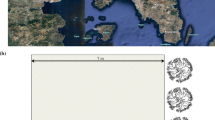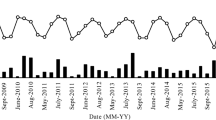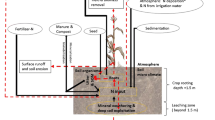Abstract
The efficiency of two common Mediterranean agroforestry systems, a potato-poplar and a maize-poplar, was assessed with respect to the uptake of nutrients and pesticides in an experimental plot located in Attica, Greece, during the cultivating period of 2016. Soil samples were collected on a monthly basis at different soil horizons and varying distance from the tree row. The monitored substances included all nitrogen ions (NO3−-N, NO2−-N, NH4+-N), phosphates (PO43−-P), potassium (K+), the insecticide chlorpyrifos, as well as the herbicides s-metolachlor, pendimethalin, and its metabolite M455H001. Experiments for the potato-poplar system exhibited reductions of more than 86% for K+, 90% for NO3−-N, 92% for NH4+-N, 85% for NO2−-N, and up to 100% for PO43−-P. Accordingly, for the maize-poplar system, reductions were more than 73% for K+, at least 77% for NO3−-N, approximately 77% for NO2−-N, 97% for NH4+-N, and up to 100% for PO43−-P. Regarding the examined pesticides, all substances reached more than 61.5% and up to 100% disappearance in the closest to the tree row points compared to the control points, thus also exhibiting the potential for tree uptake of the excess pesticides. As such, it was demonstrated that agroforestry alley cropping systems may act as a technique for pollution abatement, since tree roots that extend below the crops can uptake the excess of agrochemicals that would otherwise enter groundwater via leaching or surface water via runoff.










Similar content being viewed by others
References
Alister, C. A., Gomez, P. A., Rojas, S., & Kogan, M. (2009). Pendimethalin and oxyfluorfen degradation under two irrigation conditions over four years application. Journal of Environmental Science and Health Part B, 44(4), 337–343.
Allen, S., Jose, S., Nair, P., Brecke, B., Nkedi-Kizza, P., & Ramsey, C. (2004). Safety-net role of tree roots: evidence from a pecan (Carya illinoen- sis K. Koch)–cotton (Gossypium Hirsutum L.) alley cropping system in the Southern United States. Forest Ecology and Management, 192, 395–407.
Andrianarisoa, K., Dufour, L., Bienaime, S., Zeller, B., & Dupraz, C. (2016). The introduction of hybrid walnut trees (Juglans Nigra x Regia cv. NG23) into cropland reduces soil mineral N content in autumn in Southern France. Agroforestry Systems, 90, 193–205.
Ballabio, C., Panagos, P., & Montanarella, L. (2016). Mapping topsoil physical properties at European scale using the LUCAS database. Geoderma, 261, 110–123.
Borin, M., Vianello, M., Morari, F., & Zanin, G. (2005). Effectiveness of a buffer strip in removing runoff pollutants from a cultivated field in North-East Italy. Agriculture, Ecosystems and Environment, 105, 101–114.
Borin, M., Passoni, M., Thiene, M., & Tempesta, T. (2010). Multiple functions of buffer strips in farming areas. European Journal of Agronomy, 32, 103–111.
Coussement, T., Janssens, P., Elsen, A., Pardon, P., Nelissen, V., Reubens, B., Vandendriessche, H. (2018). Impact of trees on soil nitrogen dynamics in temperate silvoarable agroforestry systems. Proceedings of the 4th European Agroforestry Conference, Agroforestry as Sustainable Land Use, 28–30 May 2018, Nijmegen, The Netherlands. pp. 250–254.
Dollinger, J., Lin, C.-H., Udawatta, R. P., et al. (2019). Influence of agroforestry plant species on the infiltration of S-Metolachlor in buffer soils. Journal of Contaminant Hydrology. https://doi.org/10.1016/j.jconhyd.2019.103498.
European Commission (1991). Council Directive 91/414/EEC of 15 July 1991 concerning the placing of plant protection products on the market. OJ L 230, 19/08/91.
European Commission (2004). Review report for the active substance S-Metolachlor. SANCO/1426/2001 - rev. 3 (Available online at: http://ec.europa.eu/food/plant/pesticides/eu-pesticides-database/public/?event=activesubstance.ViewReview&id=381 accessed 9/6/2019).
European Commission (2009a). Regulation No 1107/2009 of the European Parliament and of the Council of 21 October 2009 concerning the placing of plant protection products on the market and repealing Council Directives 79/117/EEC and 91/414/EEC. OJ L 309, 4.11.2009.
European Commission. (2009b). Directive 2009/128/EC of the European Parliament and of the Council of 21 October 2009 establishing a framework for community action to achieve the sustainable use of pesticides. OJ L, 309, 24.11.2009.
European Food Safety Authority (EFSA) (2014). Peer review of the pesticide risk assessment of the active substance chlorpyrifos. EFSA Journal, 2014;12(4):3640.
European Food Safety Authority (EFSA) (2016). Peer review of the pesticide risk assessment of the active substance pendimethalin. EFSA Journal, 14(3):4420, 1–212.
European Soil Data Centre (ESDAC) (2018). ESDAC database. (Available online at: http://esdac.jrc.ec.europa.eu/ accessed 5/6/2019), European Commission, Joint Research Centre.
Friend, A. L., Scarascia-Mugnozza, G., Isebrands, J. G., & Heilman, P. E. (1990). Quantification of two-year-old hybrid poplar root systems: morphology, biomass, and 14C distribution. Tree Physiology, 8, 109–119.
Gikas, G. D. (2014). Water quality of drainage canals and assessment of nutrient loads using QUAL2Kw. Environ. Process., 1, 369–385. https://doi.org/10.1007/s40710-014-0027-5.
Gikas, G. D., Tsihrintzis, V. A., & Sykas, D. (2016). Effect of trees on the reduction of nutrient concentrations in the soils of cultivated areas. Environmental Monitoring and Assessment, 188(327), 1–19.
Guse, B., Pfannerstill, M., & Fohrer, N. (2015). Dynamic modelling of land use change impacts on nitrate loads in rivers. Environ. Process., 2, 575–592. https://doi.org/10.1007/s40710-015-0099-x.
Jones, R.J.A., Hiederer, R., Rusco, E., Loveland, P.J., Montanarella, L. (2003). Topsoil organic carbon in Europe. Proceedings of the 4thEuropean Congress on Regional Geoscientific Cartography and Information Systems.
Jones, R. J. A., Hiederer, R., Rusco, E., Loveland, P. J., & Montanarella, L. (2005). Estimating organic carbon in the soils of Europe for policy support. European Journal of Soil Science, 56, 655–671.
Jose, S. (2009). Agroforestry for ecosystem services and environmental benefits: an overview. Agroforestry Systems, 76(1), 1–10.
Long, Y. H., Li, R. T., & Wu, X. M. (2014). Degradation of S-metolachlor in soil as affected by environmental factors. Journal of Soil Science and Plant Nutrition, 14(1), 189–198.
Manevski, K., Jakobsen, M., Kongsted, A. G., Georgiadis, P., Labouriau, R., Hermansen, J. E., & Jørgensen, U. (2019). Effect of poplar trees on nitrogen and water balance in outdoor pig production – a case study in Denmark. Science of the Total Environment, 646, 1448–1458.
Mateo-Sagasta, J., Zadeh, S. M., Turral, H., & Burke, J. (2017). Water pollution from agriculture: a global review, Executive summary. Rome, Italy: FAO Colombo, Sri Lanka: International water management institute (IWMI). Land and Ecosystems (WLE): CGIAR Research Program on Water.
Nava-López, M. Z., Diemont, S. A. W., Hall, M., et al. (2016). Riparian buffer zone and whole watershed influences on river water quality: implications for ecosystem services near megacities. Environ. Process., 3, 277–305. https://doi.org/10.1007/s40710-016-0145-3.
Nerlich, K., Graeff-Honninger, S., & Claupein, W. (2013). Agroforestry in Europe: a review of the disappearance of traditional systems and development of modern agroforestry practices, with emphasis on experiences in Germany. Agroforestry Systems, 87, 475–492.
O'Connell, P. J., Harms, C. T., & Allen, J. R. (1998). Metolachlor, S-metolachlor and their role within sustainable weed-management. Crop Protection, 17(3), 207–212.
Otto, S., Vianello, M., Infantino, A., Zanin, G., & Di Guardo, A. (2008). Effect of a full-grown vegetative filter strip on herbicide runoff: maintaining of filter capacity over time. Chemosphere, 71, 74–82.
Panagos, P., Van Liedekerke, M., Jones, A., & Montanarella, L. (2012). European Soil Data Centre: response to European policy support and public data requirements. Land Use Policy, 29(2), 329–338.
Passeport, E., Richard, B., Chaumont, C., Margoun, C., Liger, L., Gril, J. J., & Tournebize, J. (2014). Dynamics and mitigation of six pesticides in a “wet” forest buffer zone. Environmental Science and Pollution Research, 21, 4883–4894.
Pavlidis, G., & Tsihrintzis, V. A. (2018). Environmental benefits and control of pollution to surface water and groundwater by agroforestry systems: a review. Water Resources Management, 32(1), 1–29.
Pavlidis, G., Tsihrintzis, V. A., Karasali, H., & Alexakis, D. (2018). Tree uptake of excess nutrients and herbicides in a maize-olive tree cultivation system. Journal of Environmental Science and Health, Part A, 53(1), 1–12.
Pavlidis, G., Karasali, H., & Tsihrintzis, V. A. (2019). Development and validation of a simple and efficient method for the determination of pendimethalin and its metabolite M455H001 in soil by liquid chromatography–tandem mass spectrometry (LC-MS/MS). Analytical Letters, 52(4), 1–12.
Popov, V. H., Cornish, P. S., & Sun, H. (2006). Vegetated biofilters: the relative importance of infiltration and adsorption in reducing loads of water-soluble herbicides in agricultural runoff. Agriculture, Ecosystems and Environment, 114(2–4), 351–359.
PPDB (2019a). S-metolachlor. Available online at: https://sitem.herts.ac.uk/aeru/ppdb/en/Reports/1027.htm (last accessed: 25/05/2019).
PPDB (2019b). Chlorpyrifos. Available online at: https://sitem.herts.ac.uk/aeru/ppdb/en/Reports/154.htm (last accessed: 25/05/2019).
Racke, K. D., Fontaine, D. D., Yoder, R. N., & Miller, J. R. (1994). Chlorpyrifos degradation in soil at termiticidal application rates. Pesticide Science, 42(1), 43–51.
SANCO (2010). SANCO/825/00 guidance document rev. 8.1. Available online at: https://ec.europa.eu/food/sites/ food/files/plant/docs/pesticides_ppp_app-proc_guide_res_post-reg-cont-monitor.pdf (Last accessed: 23/5/2019).
Solis, M., Paracampo, A., Bonetto, C. et al. (2019). Acute toxicity of chlorpyrifos to Hyalella curvispina: comparison of species sensitivity and assessment of environmental risk. Environ. Process., 6, 107–117. https://doi.org/10.1007/s40710-019-00352-3.
Sondhia, S. (2012). Dissipation of pendimethalin in soil and its residues in chickpea (Cicer arietinum L.) under field conditions. Bulletin of Environmental Contamination and Toxicology, 89(5), 1032–1036.
Triantafyllidis, V., Hela, D., Salachas, G., Dimopoulos, P., & Albanis, T. (2009). Soil dissipation and runoff losses of the herbicide pendimethalin in tobacco field. Water, Air, and Soil Pollution, 201(1–4), 253–264.
Tsiropoulos, N. G., & Lolas, P. C. (2004). Persistence of pendimethalin in cotton fields under sprinkler or drip irrigation in Central Greece. International Journal of Environmental Analytical Chemistry, 84(1–3), 199–205.
Udawatta, R. P., Garrett, H. E., & Kallenbach, R. (2011). Agroforestry buffers for nonpoint source pollution reductions from agricultural watersheds. Journal of Environmental Quality, 40, 800–806.
Westra, E. P., Shaner, D. L., Westra, P. H., & Chapman, P. L. (2014). Dissipation and leaching of pyroxasulfone and S-metolachlor. Weed Technology, 28(1), 72–81.
Yang, L., Ding, X., Liu, X., Li, P., & Eneji, A. E. (2016). Impacts of long-term jujube tree/winter wheat–summer maize intercropping on soil fertility and economic efficiency—a case study in the lower North China Plain. European Journal of Agronomy, 75, 105–117.
Zhu, X., Liu, W., Chen, J., Bruijnzeel, L. A., Mao, Z., Yang, X., Cardinael, R., Meng, F.-R., Sidle, R. C., Seitz, S., Nair, V. D., Nanko, K., Zou, X., Chen, C., & Nair, V. D. (2019). Reductions in water, soil and nutrient losses and pesticide pollution in agroforestry practices: a review of evidence and processes. Plant and Soil. https://doi.org/10.1007/s11104-019-04377-3.
Funding
The study was funded from Hellenic State Scholarships Foundation (IKY) and Siemens through the Research Scholarship Program “Research Projects for Excellence IKY/SIEMENS”, Grant No 2603.
Author information
Authors and Affiliations
Corresponding author
Ethics declarations
Conflict of Interest
The authors declare that they have no conflict of interest.
Additional information
Publisher’s Note
Springer Nature remains neutral with regard to jurisdictional claims in published maps and institutional affiliations.
Rights and permissions
About this article
Cite this article
Pavlidis, G., Karasali, H. & Tsihrintzis, V.A. Pesticide and Fertilizer Pollution Reduction in Two Alley Cropping Agroforestry Cultivating Systems. Water Air Soil Pollut 231, 241 (2020). https://doi.org/10.1007/s11270-020-04590-2
Received:
Accepted:
Published:
DOI: https://doi.org/10.1007/s11270-020-04590-2




